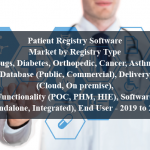OVERVIEW
The Clinical Trial Imaging Market is currently valued at USD 1.3 billion in 2024 and will be growing at a CAGR of 7.8% over the forecast period to reach an estimated USD 1.9 billion in revenue in 2029. The clinical trial imaging market plays a vital role in modern healthcare research, facilitating the evaluation of novel therapies and medical interventions. Utilizing advanced imaging techniques such as magnetic resonance imaging (MRI), computed tomography (CT), positron emission tomography (PET), and others, this market segment provides invaluable insights into the efficacy and safety of experimental drugs and treatments. These imaging modalities enable researchers to visualize physiological changes, disease progression, and treatment responses in real-time, allowing for more informed decision-making throughout the clinical trial process. Moreover, with the growing emphasis on personalized medicine and precision healthcare, the demand for innovative imaging solutions continues to escalate, driving advancements in technology and expanding the scope of clinical trial imaging. As a result, the market encompasses a diverse array of stakeholders, including pharmaceutical companies, contract research organizations (CROs), academic institutions, and imaging equipment manufacturers, all collaborating to accelerate the development of new therapeutic interventions and improve patient outcomes.
The increasing prevalence of chronic diseases and the growing demand for innovative treatment options have propelled pharmaceutical companies and research organizations to conduct extensive clinical trials. These trials often require advanced imaging techniques to assess the safety and efficacy of potential therapies, driving the demand for clinical trial imaging services. Moreover, the rising adoption of precision medicine and personalized healthcare approaches has created a need for more accurate diagnostic tools and therapeutic strategies. Imaging modalities such as MRI, CT, and PET offer valuable insights into disease mechanisms, treatment responses, and patient-specific characteristics, making them indispensable in the development of personalized treatment regimens. Furthermore, regulatory agencies worldwide have been emphasizing the importance of robust imaging endpoints in clinical trials to ensure the reliability and validity of study results. As a result, sponsors are increasingly integrating imaging biomarkers and endpoints into their trial designs, driving the demand for specialized imaging expertise and services.
Table of Content
Market Dynamics
Drivers:
The increasing prevalence of chronic diseases and the growing demand for innovative treatment options have propelled pharmaceutical companies and research organizations to conduct extensive clinical trials. These trials often require advanced imaging techniques to assess the safety and efficacy of potential therapies, driving the demand for clinical trial imaging services. Moreover, the rising adoption of precision medicine and personalized healthcare approaches has created a need for more accurate diagnostic tools and therapeutic strategies. Imaging modalities such as MRI, CT, and PET offer valuable insights into disease mechanisms, treatment responses, and patient-specific characteristics, making them indispensable in the development of personalized treatment regimens. Furthermore, regulatory agencies worldwide have been emphasizing the importance of robust imaging endpoints in clinical trials to ensure the reliability and validity of study results. As a result, sponsors are increasingly integrating imaging biomarkers and endpoints into their trial designs, driving the demand for specialized imaging expertise and services.
Key Offerings:
In the dynamic landscape of the clinical trial imaging market, key offerings encompass a spectrum of specialized services and solutions tailored to meet the diverse needs of pharmaceutical companies, contract research organizations (CROs), and academic institutions engaged in clinical research. These offerings typically include comprehensive imaging protocol development, leveraging the expertise of radiologists and imaging scientists to design study-specific imaging protocols optimized for precise data collection and analysis. Moreover, the market provides access to state-of-the-art imaging technologies and infrastructure, including advanced modalities such as magnetic resonance imaging (MRI), computed tomography (CT), positron emission tomography (PET), and others, equipped with cutting-edge software for image processing and analysis. Additionally, key offerings encompass centralized imaging management and oversight, streamlining the workflow of multi-center clinical trials by providing centralized image acquisition, storage, and analysis services, ensuring consistency, quality, and regulatory compliance across study sites. Furthermore, the market offers specialized expertise in imaging biomarkers and endpoints, enabling sponsors to integrate quantitative imaging metrics into their trial designs for more accurate and reliable assessment of treatment responses and disease progression.
Restraints :
The clinical trial imaging market is seeing growth, but there are a number of obstacles in the way of its sustained progress. The expensive expense of establishing and sustaining advanced imaging infrastructure and technologies, including the acquisition of hardware, software licences, and employee training, is one major barrier. Smaller pharmaceutical businesses and research organisations with low resources may find this financial burden to be especially onerous, which could limit their capacity to use imaging techniques in clinical trials. A further layer of difficulty is the complexity of the regulatory framework governing imaging-based research, which includes adhering to Good Clinical Practice (GCP) guidelines and complying with data privacy regulations. Ensuring regulatory compliance necessitates significant investments in infrastructure and expertise. Moreover, logistical difficulties including data administration and integration problems, standardising imaging methods across locations, and coordinating multi-center trials can cause delays and inefficiencies that affect the timeliness and calibre of study results. The lack of radiologists and other skilled imaging specialists who can interpret and analyse complicated imaging data also represents a major barrier, which may restrict the accessibility and scalability of imaging-based research services. To fully realise the potential of clinical trial imaging and spur future growth, industry stakeholders must work together to address these constraints by allocating resources to workforce development, regulatory harmonisation, and technological innovation.
Regional Information:
• In North America, particularly in the United States, the market is characterized by a robust regulatory framework, extensive infrastructure, and a highly competitive landscape dominated by established pharmaceutical companies, leading academic institutions, and specialized imaging service providers. The region benefits from a strong research ecosystem, with significant investments in cutting-edge imaging technologies and expertise, driving innovation and fueling demand for advanced imaging solutions in clinical trials. Moreover, the presence of key regulatory agencies such as the Food and Drug Administration (FDA) ensures rigorous oversight and compliance, instilling confidence in the quality and reliability of imaging-based research conducted in the region.
• In Europe, the clinical trial imaging market is characterized by a diverse landscape shaped by varying regulatory frameworks and healthcare systems across different countries. While regions such as Western Europe boast advanced infrastructure and expertise in imaging research, emerging markets in Eastern Europe are increasingly attracting clinical trials due to lower costs and streamlined regulatory processes. The European Medicines Agency (EMA) plays a central role in harmonizing regulatory standards and fostering collaboration among member states, facilitating the conduct of multi-center trials and promoting innovation in imaging-based research.
• In the Asia-Pacific region, the clinical trial imaging market is experiencing rapid growth driven by rising healthcare expenditure, increasing clinical trial activity, and expanding access to advanced imaging technologies. Countries such as China, Japan, and India are emerging as key hubs for clinical research, supported by government initiatives to promote innovation and attract foreign investment. However, challenges such as regulatory complexity, variability in healthcare infrastructure, and cultural differences pose barriers to market entry and expansion in this region, requiring tailored strategies and partnerships to navigate local requirements and capitalize on emerging opportunities.
Recent Developments:
• In March 2023, ICON Plc. (Ireland) announced a strategic partnership with LEO Pharma (Denmark) to scale clinical trial execution that is patient-centric and cost effective, and which will support the company’s overall ambition of building one of the most effective and efficient clinical portfolio execution organisations in the industry.
• In March 2023, Clario (US), announced the launch of a cutting-edge cloud-based image viewer tool for sponsors and contract research organizations to view images related to their clinical trials.
Key Players:
BioClinica, Bioclinica Imaging, ICON plc, PAREXEL International Corporation, BioTelemetry Research, IXICO plc, Radant Sage LLC, Intrinsic Imaging, Medical Imaging Resources, and WorldCare Clinical.
1) What is the projected market value of the Clinical Trial Imaging Market?
– The Clinical Trial Imaging Market is expected to reach an estimated value of USD 1.9 billion in revenue by 2029.
2) What is the estimated CAGR of the Clinical Trial Imaging Market over the 2024 to 2029 forecast period?
– The CAGR is estimated to be 7.8% for the Clinical Trial Imaging Market over the 2024 to 2029.
3) Who are the key players in the Clinical Trial Imaging Market?
– BioClinica, Bioclinica Imaging, ICON plc, PAREXEL International Corporation, BioTelemetry Research, IXICO plc, Radant Sage LLC, Intrinsic Imaging, Medical Imaging Resources, and WorldCare Clinical.
4) What are the drivers for the Clinical Trial Imaging Market?
– Chronic diseases and the need for innovative treatments have led to extensive clinical trials requiring advanced imaging techniques. Precision medicine and personalized healthcare have increased the demand for accurate diagnostic tools. Imaging modalities like MRI, CT, and PET provide valuable insights into disease mechanisms and treatment responses. Regulatory agencies emphasize robust imaging endpoints in clinical trials.
5) What are the restraints and challenges in the Clinical Trial Imaging Market?
– The clinical trial imaging market faces challenges due to high costs, complex regulatory requirements, logistical issues, and a shortage of qualified experts. These constraints can be particularly difficult for smaller companies and research organizations, limiting their ability to utilize imaging techniques in clinical trials. To overcome these restraints, industry stakeholders must invest in technology innovation, regulatory harmonization, and workforce development to unlock the full potential of clinical trial imaging and drive future growth.
6) What are the key applications and offerings of the Clinical Trial Imaging Market?
– The clinical trial imaging market offers specialized services and solutions for pharmaceutical companies, CROs, and academic institutions. These include comprehensive imaging protocol development, access to advanced technologies like MRI, CT, and PET, centralized imaging management, and expertise in imaging biomarkers and endpoints. These offerings ensure consistency, quality, and regulatory compliance across study sites, enabling sponsors to accurately assess treatment responses and disease progression.
7) Which region is expected to drive the market for the forecast period?
– North America is expected to have the highest market growth from 2024 to 2029
Why Choose Us?
Insights into Market Trends: Global Market Studies reports provide valuable insights into market trends, including market size, segmentation, growth drivers, and market dynamics. This information helps clients make strategic decisions, such as product development, market positioning, and marketing strategies.
Competitor Analysis: Our reports provide detailed information about competitors, including their market share, product offerings, pricing, and competitive strategies. This data can be used to inform competitive strategies and to identify opportunities for growth and expansion.
Industry Forecasts: Our reports provide industry forecasts, which will inform your business strategies, such as investment decisions, production planning, and workforce planning. These forecasts can help you to prepare for future trends and to take advantage of growth opportunities.
Access to Industry Experts: Our solutions include contributions from industry experts, including analysts, consultants, and subject matter experts. This access to expert insights can be valuable for you to understand the market.
Time and Cost Savings: Our team at Global Market Studies can save you time and reduce the cost of conducting market research by providing comprehensive and up-to-date information in a single report, avoiding the need for additional market research efforts.












